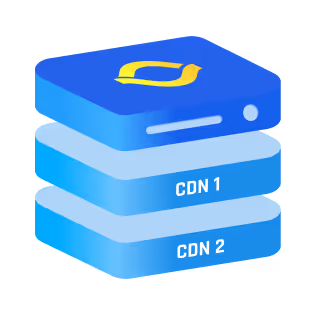What is the Primary Difference Between CDN and Edge Computing?
Table of contents
The main difference is this: a CDN moves your static content closer to users, while edge computing moves your application logic or processing closer to users. One is about speed for delivery; the other is about speed for decisions.
They're related, yeah—but they're not the same. The confusion makes sense, especially with terms floating around like CDN edge server, edge CDN, and phrases like cdn vs edge computing in blog titles.
First, What Even Is a CDN?
A CDN (Content Delivery Network) is a globally distributed network of servers. You use it to cache and serve static assets (like images, CSS files, fonts, JS bundles) close to your users.
So instead of someone in Bangalore loading your website’s images from a server in Virginia, they get them from a server much closer; say, Mumbai.
Here’s how it works in practice:
- You push static files to the CDN.
- The CDN caches those files across a global network.
- When a user makes a request, the CDN edge server closest to them handles it.
It’s simple, powerful, and does one thing really well: make static content load fast.
And this is where cdn in cloud computing shows up a lot, because most cloud providers like AWS, GCP, Azure, and Cloudflare offer CDN services baked into their stack. You upload a file to an S3 bucket or an origin server, and boom, the CDN handles caching worldwide.
So Then What’s Edge Computing?
Edge computing takes the idea of proximity—but instead of just serving cached files, you actually run logic at the edge.
That means:
- Running code close to users
- Making real-time decisions
- Processing data before it ever hits your main server
Imagine a login API that runs on an edge location instead of a centralized backend. Or a bot detection function that executes right where the request comes in. That's edge computing in action.
It’s not just about caching but rather computing near the user. That could be anything from:
- User authentication
- Personalization
- A/B testing
- Rate limiting
- Request validation
- API gateways
The Core Difference
Here’s how I explain it to people who work with me:
CDN = Let’s copy files close to users.
Edge Computing = Let’s run logic close to users.
With a CDN, you serve the same thing to everyone. With edge computing, you can serve different things, based on logic, rules, or even live data.
That’s the primary difference. One is dumb-fast, the other is smart-fast.
Let’s Take a Use Case: Image Handling
- With a CDN, you cache images in different locations. Fast, but static.
- With edge computing, you can generate or resize those images on the fly at the edge—per device, per request.
If you’ve used something like Cloudflare Workers, Fastly Compute@Edge, or AWS Lambda@Edge, you’ve already dipped your toes into this world.
What About the Edge CDN?
Here’s where it gets spicy.
An edge CDN is kind of a hybrid term. It means a CDN platform that also supports edge computing natively.
Take Cloudflare, for example. It started as a CDN, then added Workers (edge functions), durable objects, AI inferencing at the edge, and more. That’s no longer “just a CDN.” but a full-blown edge platform.
So if you hear someone say edge CDN, they’re probably talking about a CDN that supports:
- Dynamic processing
- Edge functions or edge logic
- Serverless compute nodes on edge locations
This is where cdn vs edge computing blurs a little. Because many CDN providers have become edge platforms too.
CDN vs Edge Computing - Technical Difference
For the tech-savvy, here’s how I would draw their distinctions:
1. How Execution Models Differ at the Core
CDN is pull-based or push-based content delivery. It fetches or receives static content and replicates it. There’s no execution per request—it’s content routing.
Edge computing, on the other hand, follows a compute-on-request model. It runs a function or container in real time, per user request, potentially generating a unique output.
This fundamental difference—deliver vs. execute—is key to understanding the boundary.
2. Statelessness vs. Stateful Potential
CDNs are entirely stateless. They don’t store session data or make decisions based on user context (beyond cache keys). The same image, font, or script goes to everyone.
Edge computing can be state-aware—it can read cookies, session tokens, headers, geolocation, etc., and execute logic based on that. Some platforms even offer state sharing across edge nodes.
This reinforces the main difference: CDN serves. Edge thinks.
3. Where They Sit in the Request Lifecycle
CDNs typically sit after the DNS resolution and before the origin server. They're part of the content delivery path.
Edge computing can be injected at multiple points:
- Right after DNS (e.g. Cloudflare Workers)
- On the TCP/HTTP request (e.g. Fastly VCL)
- As part of the app infrastructure (e.g. Fly.io or Vercel’s edge middleware)
This means edge computing can intercept and process requests earlier in the flow than a traditional CDN—making decisions before the request is even routed.
4. Mutability vs. Immutability
CDNs serve immutable assets—they're best when content doesn't change per request.
Edge computing thrives in mutable environments—you can change the output dynamically, even if it’s the same path. Same endpoint, different logic per user, device, or geo.
So even if the CDN and edge server are on the same network, what they do is fundamentally different. CDN delivers fixed responses; edge computes flexible ones.
5. Who Controls the Output
- With a CDN, the output is pre-defined. You set the cache headers, upload content, and that's what users get.
- With edge computing, the output can be defined at runtime. It can be conditional, personalized, even AI-generated if needed.
This answers the core difference in another form: CDN is passive. Edge computing is active.
When Would You Use Just a CDN?
If you’re only serving static assets and just want better load speeds, lower latency, and lower egress costs—stick to a classic CDN.
Use cases:
- Websites
- Blog images
- Font files
- JS/CSS assets
- Static SPAs
It’s also the easiest win for people switching from cdn vs local hosting setups. You host everything on a central server, and suddenly realize it’s way too slow for international users.
You bring in a CDN to globally mirror your content—problem solved.
When Do You Need Edge Computing?
You move to edge computing when you want:
- Per-request decisions (e.g. geolocation-based content)
- Pre-processing before a request hits your origin
- Dynamic personalization based on cookies, headers, etc.
- Real-time bot filtering
- Custom auth flows at the edge
For example, say you're building a streaming service. Your authentication and licensing checks could run at the edge before the user even hits your backend servers. That’s fast and efficient.
Or you're building a region-based pricing page. Instead of waiting for a full page load and doing a client-side redirect, you compute pricing dynamically at the edge. Done.
CDN Edge Server vs Edge Computing Node
One more point of confusion: both CDNs and edge platforms talk about “edge servers.” But they use them differently.
- A CDN edge server handles static delivery.
- An edge computing node can execute code, manage state, or even process AI workloads at the edge.
So they may physically look the same, but what they do is very different.
CDN vs Edge Computing in 1 Line
Let me leave you with the cleanest difference:
A CDN makes content delivery faster. Edge computing makes decisions faster.
And that's the real story behind cdn vs edge computing.
They both reduce latency. They both bring things closer to the user. But what they bring is different—files vs logic.
In practice, they often work together. Your app might:
- Use a CDN to deliver its frontend.
- Run edge computing to validate tokens or geo-personalize pricing.
- Fall back to centralized infrastructure for deep backend operations.
And that’s exactly how I build mine. Use the right tool at the right layer.


.png)
.png)
.png)